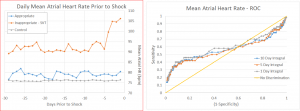Problem/Opportunity
Through legislation and lifestyle changes, consumers on average are becoming more aware of the good and bad of what they’re eating (e.g., calorie counts in states that require listing at chain restaurants), but there’s currently few ways for people to track how their diet and lifestyle truly impacts their health. Fitness monitoring has increased in popularity through the proliferation of smart devices, but there’s no automated equivalent for monitoring your diet, and even if you manually log everything you eat, it’s nearly impossible to know how your body reacts to certain foods, and if your body is getting everything it needs.
This is a problem and opportunity that reaches across age ranges and demographics. A solution that provides seamless nutritional monitoring and recommendations based on dietary shortfalls and user habits/behaviors that adjusts based on learned preferences could benefit everyone. For example, even with rigorous food tracking, elite athletes can’t truly tell if they’re getting adequate levels of, say, the eight essential amino acids. Cancer patients or those in remission don’t truly know if they’re getting enough Vitamin C or D. Diabetics can currently monitor their glucose levels, but could be at a loss in terms of what else they should be tracking. Everyday consumers may be falling short on certain vitamins and minerals, but aren’t aware of their impact or how to close those gaps.
Solution
To address the opportunity described above, we would like to reintroduce HiPo! and its next line of product, Hi-Per!. Hi-Per! is designed to continually monitor key nutrient levels in the human body and provide feedback in the form of food consumption recommendations and alerts that ensure individuals maintain optimal levels of health.
Recent developments in technology have expanded the possibilities of how sensors are used to evaluate health and wellness attributes. While existing sensor technology focuses on measuring nutrient levels of food items, we believe that the application of this technology to nutrient levels and other health metrics of an actual individual is a viable next step. Hi-Per! is housed in wearable (and fashionable) wristband sensor that uses infrared spectrometer technology to make periodic measurements of the user’s vitals and nutrient levels. This information is sent to the Hi-Per! application which is accessible on the user’s mobile device.
The application itself leverages a machine learning recommendation algorithm to evaluate the user’s vitals and nutrient levels, alert the user of any deficiencies, and suggest preferred foods to remediate those deficiencies. The algorithm is built upon a database of inputs, including: (a) benchmark vital and nutrient level data for different user profiles based on sex, age, and weight; (b) nutritional data on food and drinks; (c) research data on the metabolic profiles of both individuals and foods. Using these inputs, the algorithm will be designed to optimize a user’s food and drink consumption based on their nutrient needs, taste preferences, and individualized food digestion traits (i.e., metabolic behavior). The user will be able to log what food and drink has been consumed in the application, providing a feedback loop that will further optimize the user’s health and wellness profile.
Pilot
We conducted a pilot study on 10,000 pregnant women. A recent study showed that prenatal vitamins do not have benefits for women and their unborn children as advertised and, instead, pregnant women should focus on improving the overall quality of their diet to reduce complications related to birth and pregnancy from vitamin deficiencies. Yet there are many dietary restrictions placed on what women can consume during pregnancy. Given the heightened health awareness, benefits of optimal vitamin levels, and dietary restrictions, pregnant women represent an ideal customer base to test our technology. We focused on optimizing the top 8 nutrients pregnant women need: iron, calcium, vitamin D, folate, protein, zinc, iodine, and omega 3-fatty acids. The results drastically showed how Hi-Per! was able to improve vitamin levels in pregnant women to minimize birth defects and pregnancy complications. For example, abnormal bone growth, fractures, and rickets in newborns decreased in prevalence by 65% against control groups (attributed to vitamin D levels).
Sources:
https://www.fastcompany.com/3030342/this-tiny-device-fits-on-your-keychain-and-measures-the-calories-in-your-dinner
http://www.livescience.com/55363-prenatal-multivitamins-dont-help-much.html











